Art Sets.
Stories behind the frames
Print this setBy the Art Gallery of NSW

AGNSW collection Louis Buvelot At Lilydale 1870
This frame is in the distinctive style of Isaac Whitehead who was the most prominent framemaker in Melbourne in the 1860s and 70s. Resembling frames known to be by Whitehead in various Australian collections, this frame shares his particular method of making ‘compo’, or composition, mouldings by hand or machine to create running patterns – usually derived from flowers – to which he would add other corner botanical motifs. A major restoration treatment undertaken in 1991 removed layers of overpaint and gesso from the original gilded surface and treated the degradation of the compo allowing better definition of the patterns and crack removal.

AGNSW collection Julian Ashton The prospector 1889
Due to age or damage, the Gallery may decide to make a new frame for important works such as this one. Using photographs dating from 1898–1901, our framers were able to create an historically accurate reproduction which was completed in 2017. They were also able to incorporate the original inner slip, the only part of the original frame that had survived undamaged. The moulding on the frame has an outer scotia (a concave profile) at the back edges, a plain torus (a large convex half-circle) of the top moulding, a plain astragal (a small torus), an inner slip with a bevel at the sight edge, all sand decorated. It has been oil-gilded with imitation gold leaf, then patinated.
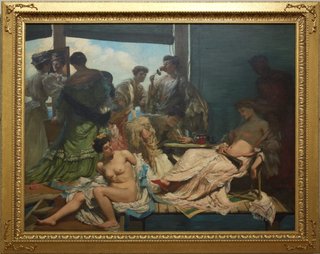
AGNSW collection Rupert Bunny Summer time circa 1907
This frame is a mix of original and later additions. The inner part is original, likely brought out from France with the painting. An outer moulding was probably added prior to the exhibition at the Athenaeum Hall in Melbourne in 1928, from which the Gallery purchased the painting. An examination of wood samples that was made when the frame was restored in 1992 showed that the inner part was made of European pine; the outer from Californian redwood, commonly imported to Australia in the 1800–50s. The inner part shows other signs of being from France, with ornaments made of plaster in the French style, whereas those on the outer part are made from composition, a material distinctive on northern European and Australian frames.

AGNSW collection Rupert Bunny A summer morning circa 1908
This painting has a Louis XIV-revival-style frame, with corner-and-centre cartouches (oval or rectangular designs with ornamental scroll work). It is a French frame and dates to the 1910s, contemporary to the painting, and may be original. All the ornaments are made of plaster, common to French frame production of the period. They were gilded with imitation gold and brass leaf (schlagmetal) using an oil-gilding technique. A major restoration of the frame was undertaken by the Gallery in 2009. Lost ornamentation was replaced and layers of dull brass-based overpainting (probably dating to the 1960s or 70s) were removed to reveal the original gilding, restoring the frame’s integrity to the painting.

AGNSW collection Maurice Felton Portrait of Mrs Alexander Spark 1840
This frame is the original commissioned from Sydney framer Solomon Lewis in 1840 by merchant and art patron Alexander Brodie Spark, the subject’s husband. Lewis, who made frames for Conrad Martens and Samuel Elyard amongst others, was married to the artist Maurice Felton’s younger sister Harriet. Similar mouldings appeared on almost all the colonial portraits known to be by Felton. The ‘ogee’ moulding (an s-shaped curve) was originally gilded using matte water-gilding on redbrown bole (a fine clay mixed with adhesive) background with burnished highlights on black bole on the corners. A brass-based overpainting was removed during conservation in 2001, revealing the original gilding.
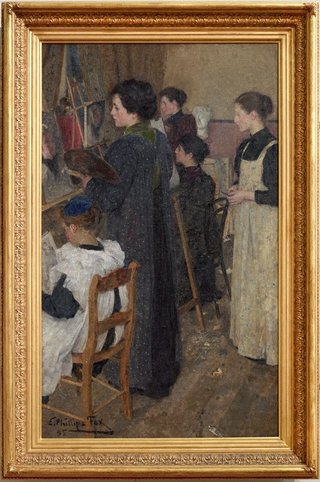
AGNSW collection E Phillips Fox Art students 1895
After the original frame for Art students went missing years ago, it was replaced by an unsuitable modern frame. In 2002, an unusual decision was made to replace the frame with that from another Phillips Fox painting in the Gallery’s collection, Lady in black 1900. Phillips Fox painted Lady in black with unstable materials which had aged to the point where it was declared beyond restoration, never to be exhibited. Its frame had fared much better and it was decided to use it for Art students. The frame’s height was reduced and it was extensively restored. Though a difficult ethical decision, the ‘swapping’ allowed for the restoration and display of a beautiful and original frame.
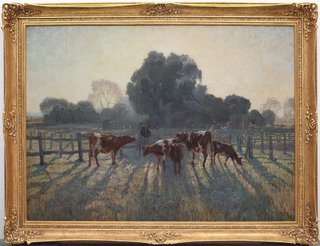
AGNSW collection Elioth Gruner Spring frost 1919
This Louis XV-revival-style frame, with its elaborate corner and centre ornaments, is original to the painting and attributed to the SA Parker framing company in Sydney. Elioth Gruner was a regular client of the Parker workshop. The Gallery’s frame conservators undertook an extensive restoration treatment in the late 1990s. The cedar frame had been buried under heavy brass-based overpainting. This was removed to allow better definition of the pattern of the ornaments, but it was impossible to retain the original gilding, which was in imitation gold leaf (Dutch metal) using an oil-gilding technique. After the removal of layers of paint and the replacement of many missing ornament parts, the entire surface of the frame was re-gilded with gold leaf.

AGNSW collection George Lambert Holiday in Essex 1910
This painting has a reproduction frame made by the Gallery in 2000. The design is based on the frame of Lambert’s Lotty and the lady at the National Gallery of Victoria, which was considered to be both original and of an appropriate design. Since completion of the new frame, a photograph was discovered in the National Gallery of Victoria archives which shows Lotty and the lady in a more elaborate rococo-style frame. The frame style first chosen by the Gallery, however, appears on several Lambert paintings, and in most instances they appear to be original.

AGNSW collection Sydney Long By tranquil waters 1894
This neoclassical-style frame, with its broad, fluted scotia and sand-decorated frieze, is original to the painting. It is believed to be a frame ordered from HW Callan by the Gallery in 1894, an order minuted in the trustees meeting of 26 September 1894. Henry W Callan was a ‘Fine Art Importer, Print Seller, Dealer in Works of Art and Picture Frame Manufacturer’ whose workshop was in Sydney’s George Street. Major restoration treatment undertaken in 2012 removed layers of extensive brass-based overpainting and degraded blackish varnishes, revealing well-preserved original gilding.
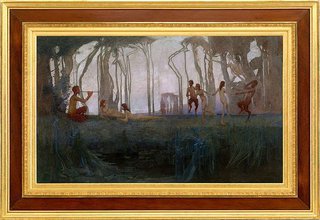
AGNSW collection Sydney Long Pan 1898
Discovered under thick layers of brass-based overpainting in 1993 were gesso foundation layers and subsequent gilding on all sections of the frame except the inner frieze: the frieze had been left with a natural wood finish. When the overpainting was removed, it showed the original gilding had been damaged prior to being painted. When the frame was re-gilded with gold leaf following the original gilding scheme, the frieze was left just varnished to expose the natural wood grain. Several years later, the findings were confirmed when a photograph of the work hanging in the Gallery in the early 1900s surfaced.
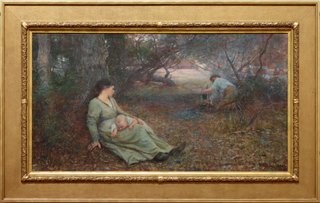
AGNSW collection Frederick McCubbin On the wallaby track 1896
On the wallaby track sports a reproduction frame made by the Gallery in 1997. The new frame was based on a photograph in the Gallery’s archive showing the painting in its original frame which had a distinctive design that pointed to the likelihood of it being made by the Melbourne workshop of John Thallon. Traditionally a detailed frame description lists all the elements from the outer to the inner edges, so for this frame that would be: fillet at back edge; taenia; three-quarter plain astragal; sanded frieze; fillet; oak leaf torus with ribbons at the corners and the centres; fillet; slip with large cavetto at sight edge.
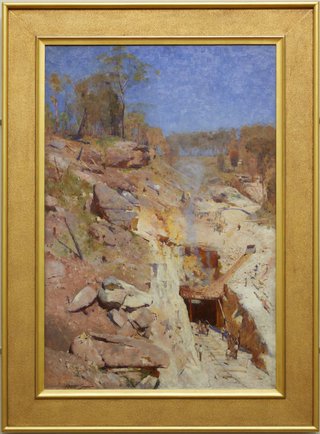
AGNSW collection Arthur Streeton Fire's on 1891
Fire’s on has had three frame changes since it was painted; all three were likely chosen by the artist. The original frame can be seen in a photograph of the painting hanging at the Victorian Artists’ Society exhibition in Melbourne. According to letters in the Gallery’s archive, Arthur Streeton sought an update and the frame was removed in the early 1900s. The second frame was similar to one on another Gallery painting by Streeton, Boulogne 1918. The third frame was probably attached in the late 1920s. In a letter to the Gallery’s trustees in the early 1930s, Streeton wrote that he liked the first frame best after all. In 2013, one was made by the Gallery using the photograph of the first frame as a guide.
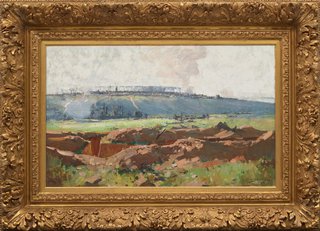
AGNSW collection Arthur Streeton Villers-Bretonneux 1918
The Louis XIV-revival-style frame was popular from the mid 1800s to the 1920s. It consists of a wooden moulding enriched with undulating and deeply recessed plaster foliage on a crosshatched ground that runs along all sides. The pattern was popular for landscape paintings, but a large-scale version also surrounds Édouard Manet’s famous Olympia 1863 – its frame selected by Claude Monet when he organised for its purchase by the French government in 1890. The Villers-Bretonneux frame had its gilded finish painted over with brass-based paint. A major restoration in 2017 removed thick layers of the paint from the frame revealing the well-preserved original gilding.
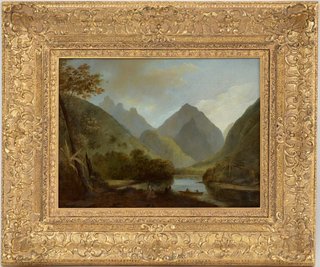
AGNSW collection John Webber A view in Otaheite Peha 1785
An indentation in the edges of the paint layers of this Régence style carved frame suggests that it was adapted to the painting shortly after it was finished. Over time, multiple layers have been applied to the frame’s surface, obscuring the reparure (the detailing of the gesso surface) and the cross-hatching. A major restoration of the frame was undertaken in 2016. Thorough investigation was conducted to determine the original gilding scheme using state-of-the-art conservation technology, from advanced x-rays to scanning electron microscopy. The intricate restoration process revived the original decoration and restored the integrity of the painting by restoring its original gilding structure.
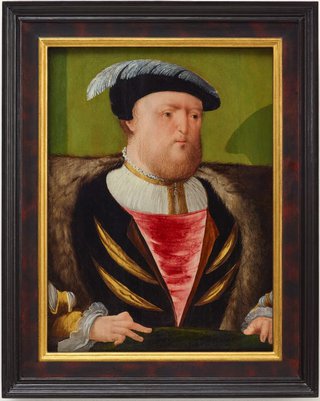
AGNSW collection Anglo-Netherlandish workshop King Henry VIII circa 1535-circa 1540
During the Tudor era the frame was an integral part of the artwork. The oak frame was attached to the panel prior to preparation and painting. Unfortunately, few original frames survive on Tudor paintings. The reproduction frame on this painting was based on two surviving originals – Portrait of Katherine of Aragon (Lambeth Palace collection, London) and a Portrait of Henry VIII (National Portrait Gallery, London). The outer moulding of the frame was painted with lampblack (a pigment made from soot) followed by a clear resin-based varnish, while the central inner frieze was decorated with imitation tortoiseshell, created with brushstrokes of smoky azurite applied over the red-ochre base and finished with a reddish oil-base coating.
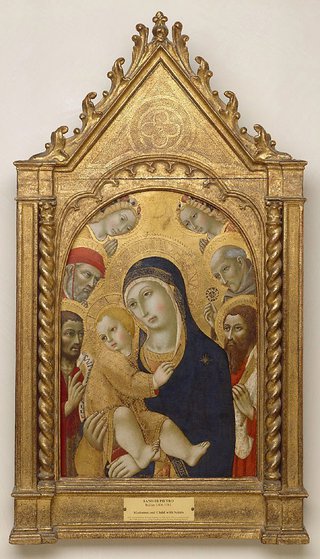
AGNSW collection Sano di Pietro Madonna and Child with Saints Jerome, John the Baptist, Bernardino and Bartholomew 1450-1481
This ‘tabernacle’ frame was inspired by Gothic architecture. The gable is decorated with flame-like acanthus crockets and is capped with a pinnacle. While its style harmonises with that of Madonna and child and is appropriate for the period, the frame was customised later for the painting. Indeed the network of cracks covering the gilded surface is not related to the natural movement of the panel’s wood that occurred over time. In early Italian paintings, picture and frame were commonly glued and nailed together, then covered with gesso and gold, before the picture was painted.
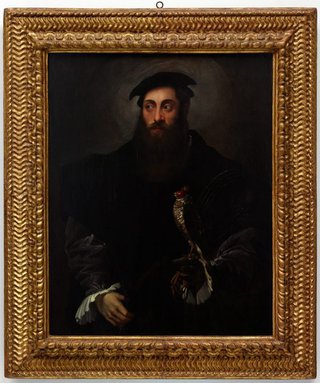
AGNSW collection Nicolò dell'Abate Portrait of a gentleman with a falcon circa 1548-circa 1550
This Italian wooden frame is contemporary to the painting and known as a ‘mannerist’ frame. It was however added to the painting later – there are traces of recutting and some relatively new dove-tail tenons in the middle section of each side. The frame was hand-carved before being gilded and burnished on a red bole (a fine clay mixed with animal glue) foundation. The style of the frame is particularly dynamic thanks to its bolection profile (a decorative moulding that projects beyond the main face of the frame). The ornament consists of rippling waveforms, known as strigillated ornament, which became fashionable in the 16th century.
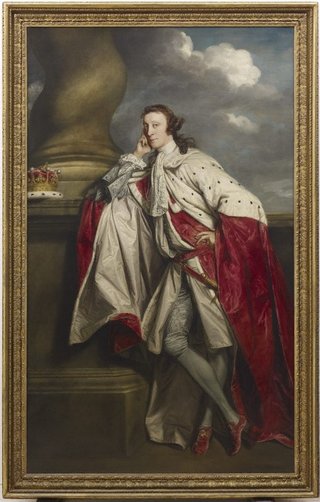
AGNSW collection Sir Joshua Reynolds James Maitland, 7th Earl of Lauderdale 1759-1760
This Roman neoclassical-style frame, known as a ‘Carlo Maratta’, is a British variant of the Italian ‘Salvator Rosa’ frame and was introduced to 18th-century Britain by collectors returning from the ‘Grand Tour’ in Europe. The Carlo Maratta became the most widely used picture frame in Britain from the mid to the end of 1700s, notably for portraits by leading painters Joshua Reynolds and Thomas Gainsborough. Without the complication of added corner ornaments, these frames were economical and could be bought ready-made or quickly made to measure. Here the basic format has been ornamented, notably with a band of acanthus leaves and shields.
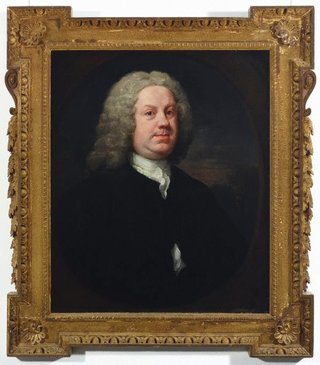
AGNSW collection William Hogarth Dr Benjamin Hoadly MD early 1740s
The most distinctively British frame is the ‘Kent’ frame. Named after the architect William Kent, its style relates intimately to Palladian architecture. The Kent frame is instantly recognisable by its classic form, with projecting square or ‘ear’ corners, raised inner and outer architectural mouldings with a flat main section decorated with sand or an architectural pattern, as well as pendant oak leaves and acorns on each side. It was the dominant style in Britain in the 1720s, but lasted well into neoclassicism later in the century. The present frame is contemporary to the painting but is not the original.

AGNSW collection William Henry Margetson The sea hath its pearls 1897
This frame is a striking example of the 19th-century phenomenon of the artist-designed frame, which plays a vital role in a viewer’s response to the painting. The running ornament with crab motifs carved in low relief in the circle, corresponds with the seaside theme of the painting. It encloses the open composition and forms an integral part of the theme of the work of art. In reaction against the mechanical mass production of 19th-century frames, numerous artists favoured frames made of oak and hand-carved.
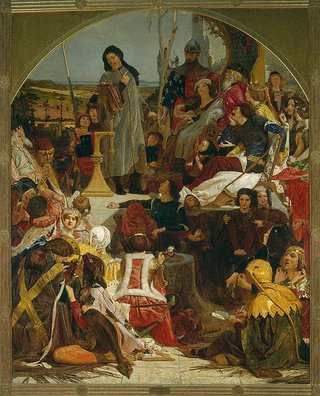
AGNSW collection Ford Madox Brown Chaucer at the court of Edward III 1847-1851
For Ford Madox Brown, as for the other Pre-Raphaelites, the integral relationship between painting and frame was vitally important. This frame is an excellent example of the revolutionary new approach to frame design with its simplified, strictly rectilinear shape. It comprises an outer moulding which is reeded and interrupted by simple squares at the corners and roundels on the sides. The corners are not mitred but butt-joined. This is the typical reed and roundel frame, which came into use in the early 1860s.

AGNSW collection Sir Edward John Poynter The visit of the Queen of Sheba to King Solomon 1881-1890
This original frame, designed by Poynter himself, is a great example of the ‘aedicular’ or temple-like frame. Consisting of a pedestal, two pilasters at the sides, an entablature and a slip, the frame plays an essential role in the overall conception of this work. While a number of decorative motifs in the architectural background of the painting are repeated in the frame, the overall architectural theme is the most prominent. The frame was gilded with gold leaf using two techniques: oil-gilding for the ornamented parts and matte water-gilding for the flat surfaces.

AGNSW collection Sir Lawrence Alma-Tadema Cleopatra 1875
The heyday of the artist’s frame was the second half of the 19th century. The period witnessed the experiments of the Pre-Raphaelites, the aesthetic frames of Whistler and Albert Moore as well as the grandest efforts of Leighton, Alma-Tadema and Burne-Jones. This frame was specially designed for Cleopatra in 1875, and even the style of the lettering of the inscription is part of the message of the subject. The inscription in hieroglyphs on the frame accompanies this representation of Cleopatra and reads ‘Ruler of two lands Cleopatra Queen’. The hieroglyphs are carved into the gesso on the slip surface while the artist’s name is written in black paint.
Alongside the Pre-Raphaelites, Watts was much preoccupied with the design of frames for his pictures and is credited with the introduction of a frame model derived from an Italian Renaissance cassetta frame (essentially an extended entablature wrapped around all sides of the image), which became extremely popular in the 1880s. In its classic form the frame is gilded directly onto the oak and comprises a main wide flat frieze as well as raised inner and outer mouldings in composition or ‘compo’ (a pliable mixture which can be pressed to make moulded ornament) and butt-joined corners. From 1861, Watts used this frame style on most of his paintings and it was adopted by many Victorian artists.
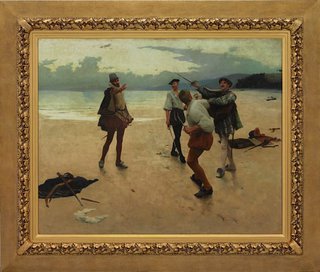
AGNSW collection Frank Wright Bourdillon On Bideford Sands 1889
In the past, numerous paintings in the Gallery were removed from their original frames, with the result that many of the separated frames were destroyed. At present, the design and creation of appropriate reproduction frames is one of the major activities of the conservation department. A thorough investigation of the artist, the period and the artwork precedes each reframing project. Old photographs from the Gallery’s archive are often of outstanding value for research. The present reproduction frame was made in 2016 according to a 19th-century photograph of the work on display in its original frame.

AGNSW collection Nasreddine Dinet The snake charmer 1889
This original frame for The snake charmer, decorated with plaster oriental-style ornaments, was originally gilded using gold leaf. In the 1950s, the surface of the frame was unwisely coated with brass-based paint, causing the frame to look flat and plastic. A distinctive alligator-type network of fine cracks became apparent under the paint layer and caused progressive deterioration of the frame. The frame went through a major restoration in 2012 which revealed its original gilding.
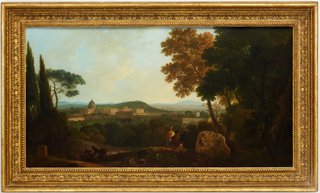
AGNSW collection Richard Wilson St Peter's and the Vatican from the Janiculum, Rome 1757-1764
The hand-carved decoration of this classic ‘Carlo Maratta’ frame – notably the twisted ribbon-and-stick, the acanthus-and-shield and the bead motifs – does not follow a logical pattern. The irregularities of the human hand, rather than machine-like perfection, give a freshness and liveliness to the ornaments which would be impossible to achieve using a mould.

AGNSW collection Camille Pissarro Peasants' houses, Éragny 1887
Major innovations in frames were instituted in the 1870s and 1880s by the impressionist painters, who frequently exhibited their works in simple white or coloured frames. However virtually no original impressionist frames seem to have survived. Pissarro placed enormous importance on the frames surrounding his paintings, but this Louis XIV-style carved and gilded frame was probably put on the painting by the leading impressionist art dealer Paul Durand-Ruel around 1891. A white painted slip was inserted in 2005 by the Gallery’s conservators to recall Pissarro’s original white frame, which was described by the artist in a letter to his son Lucien in March 1887.
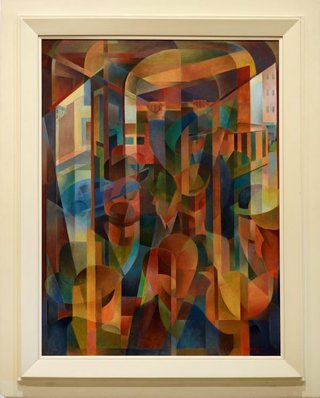
AGNSW collection Frank Hinder Tram kaleidoscope 1948
This plain modern frame with its masonite outer moulding, was made by the artist. This was not unusual for modernists such as Frank Hinder, who sought the harmonious integration of all the elements that make up a work of art. Hinder certainly had the skills to make the right frames for his paintings, with a diversified practice that included theatre design, commercial art, teaching and assisting his wife Margel Hinder with her large sculpture commissions. At one point the original cream-coloured paint was painted over with a greyish paint, since removed by the Gallery’s frame conservators.